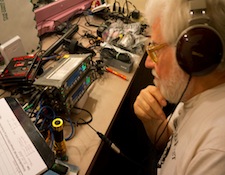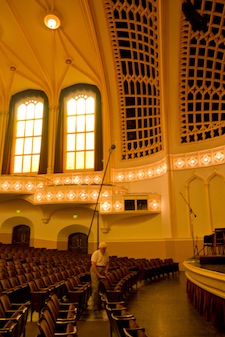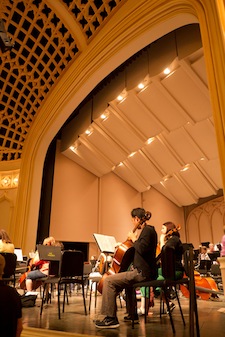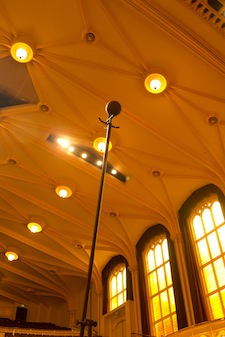It’s the time of year for saving money!

Every year, for the past eighteen years, Jerry Bruck has made a trip to Boulder, Colorado for the sole purpose of recording Boulder’s annual Mahlerfest. The festival’s artistic director and conductor, Robert Olsen, has less than a week to pull together the orchestra to perform Mahler’s lifework, and Jerry flies in from NYC to record it.
For audiophiles unfamiliar with Jerry Bruck, he began his professional career as an audio engineer at St. Louis’ KCFM, but soon moved to NYC where he joined WBAI in 1961. By the mid-60’s Bruck had begun his career as a freelance recording engineer. He’s twice been a Governor of AES (Audio Engineering Society), as well as the chairman of AES’ New York branch three times. In 1999 Bruck received the AES Fellowship award for his work.
For a couple of years J. Gordon Holt and I also recorded the main concert at Mahlerfest, but Gordon’s failing health and the daunting task of trying to fit our mic stands and cables onto the stage that was already full of performers, Bruck’s gear, and a plethora of video cameras, gave parts of the stage the look of a radar array. Also, Bruck’s recordings were so superb that it was obvious to Gordon and myself after listening to them that there was little point in our recording the event as well.

For this year’s Mahlerfest Jerry and his assistant Michael Karas flew into town on Wednesday afternoon where they met up with Eric Wagner, who now lives in Colorado, but used to work with Jerry in NYC. Their next stop was University of Colorado’s Macky Auditorium where Bruck’s crew of three began setting up for the first rehearsal that would begin at 7:00 PM that evening. I volunteered to help with the scut work of laying cables and carrying gear, but when I arrived at 6:00 PM all the cables and microphones were already in place and Bruck and his crew were in the final stages of the set-up. So instead of performing meaningful work, I found a comfy chair and sat down to watch Jerry make his final adjustments.
For 26 years Jerry Bruck was the United States distributor for Schoeps microphones, and he’s been using them for his own recordings for even longer than that. Few people have more experience using Schoeps microphones, especially Schoeps’ unique KFM-360 “Sphere” microphone. Bruck even developed a “Purist’s Surround Sound System” based around a dual M/S adaptation of the KFM-360.
For this year’s Mahlerfest Bruck used his Schoeps KFM-360 sphere microphone on a large floor-standing boom as his main stereo microphone. But in addition to the KFM-360 Bruck employed a pair of Schoeps Colette mics with MK-21 capsules in a quasi-ORTF arrangement that flanked the KFM-360. Bruck planned to use the ORTF array to add more width to the KFM-360’s stereo image. Bruck also used two “spot microphones,” Schoeps Collettes with new MK-22 capsules. One microphone was for the soprano soloist in Mahler’s 4th symphony, the other was for the high-tuned fiddle solo in the second movement. Bruck used two four-channel Sound Devices 744T recorders so that he could record each of his six microphone channels onto its own track and do the final mix later. The KFM-360 and MK-21 ORTF tracks used the 744T’s built-in microphone preamps while the two solo mics were plugged into a AETA Mix2000 microphone preamp/mixer and then ported over to the Sound Devices recorders via their line-in inputs.

During the rehearsal Wednesday night I listened via headphones to the feed coming from both the KFM-360 and the MK-21 ORTF array. Both shared a certain harmonic rightness that I’ve long associated with Schoeps microphones. I preferred the overall presentation of the KFM-360, especially its powerful but nuanced low frequency response, but the MK-21s delivered slightly more of the reflected sound in the room coming off the walls and rear proscenium.
I returned to Macky Auditorium on Friday evening to hear the first of two performances of Mahler’s 4th Symphony and the “Der Abschied” (The Farewell) from Das Lied von der Erde. I listened to the feed from the Schoeps KFM-360 through my BeyerDynamic DT-770 headphones. Usually I use a pair of Stax earspeakers for location monitoring, but since I was sharing a smallish room with three other engineers, the DT-770’s closed-ear design provided the level of isolation required for working in these close quarters. The mic feed from the KFM-360 sounded glorious – warm, rich, vibrant, with a noise floor that made every musical (and amusical) detail stand out. Since this was a live concert recording, audience noises, such as the occasional cough or sneeze, were in attendence.

Since the principal concert at Mahlerfest has two performances, Bruck had two recordings to choose from to make the final recorded version. The runner-up version serves as back-up to use to fill in where an audience cough or banged music stand on stage would otherwise disturb the musical flow. Most of the edits Bob Olsen requests from editor Eric Wagner are for extra-musical corrections, not for better “takes” of a particular solo or passage.
It usually takes a couple of months for the final mixdown and edits to be completed, but if you want to hear some of Jerry Bruck’s recordings from past Mahlerfests, you can find them on Colorado Mahlerfest’s website. If you like Mahler’s music and haven’t heard any of Bruck’s recordings from Mahlerfest, you are in for a real treat. When it comes to live concert performance recordings, it doesn’t get any better than this…





